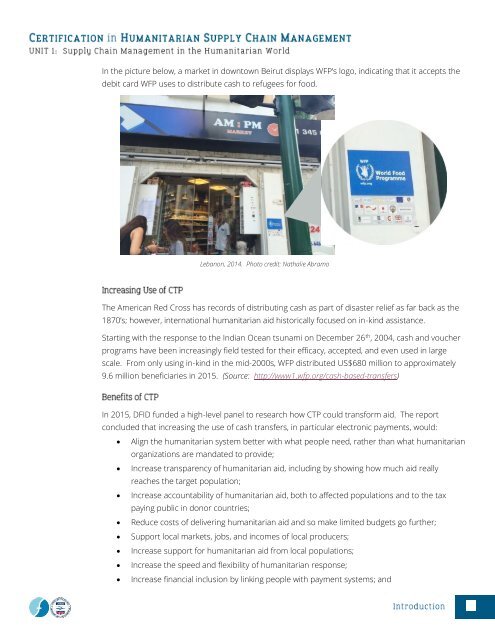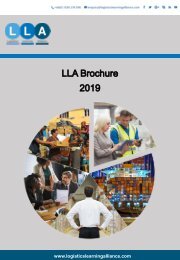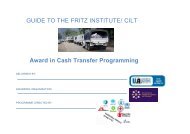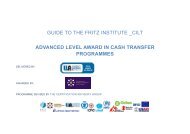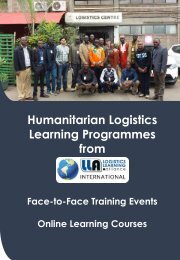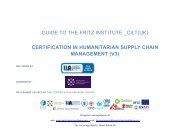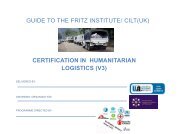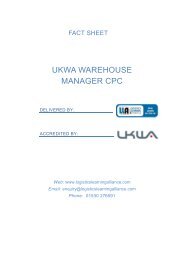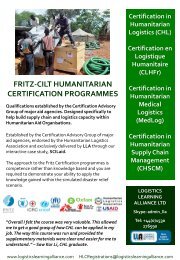CHSCM 3.0 - Unit 1 - SCM in the Humanitarian World
Learning Materials for Unit 1 of the Certification in Humanitarian Supply Chain Management (CHSCM).
Learning Materials for Unit 1 of the Certification in Humanitarian Supply Chain Management (CHSCM).
Create successful ePaper yourself
Turn your PDF publications into a flip-book with our unique Google optimized e-Paper software.
In <strong>the</strong> picture below, a market <strong>in</strong> downtown Beirut displays WFP’s logo, <strong>in</strong>dicat<strong>in</strong>g that it accepts <strong>the</strong><br />
debit card WFP uses to distribute cash to refugees for food.<br />
Lebanon, 2014. Photo credit: Nathalie Abramo<br />
The American Red Cross has records of distribut<strong>in</strong>g cash as part of disaster relief as far back as <strong>the</strong><br />
1870’s; however, <strong>in</strong>ternational humanitarian aid historically focused on <strong>in</strong>-k<strong>in</strong>d assistance.<br />
Start<strong>in</strong>g with <strong>the</strong> response to <strong>the</strong> Indian Ocean tsunami on December 26 th , 2004, cash and voucher<br />
programs have been <strong>in</strong>creas<strong>in</strong>gly field tested for <strong>the</strong>ir efficacy, accepted, and even used <strong>in</strong> large<br />
scale. From only us<strong>in</strong>g <strong>in</strong>-k<strong>in</strong>d <strong>in</strong> <strong>the</strong> mid-2000s, WFP distributed US$680 million to approximately<br />
9.6 million beneficiaries <strong>in</strong> 2015. (Source: http://www1.wfp.org/cash-based-transfers)<br />
In 2015, DFID funded a high-level panel to research how CTP could transform aid. The report<br />
concluded that <strong>in</strong>creas<strong>in</strong>g <strong>the</strong> use of cash transfers, <strong>in</strong> particular electronic payments, would:<br />
• Align <strong>the</strong> humanitarian system better with what people need, ra<strong>the</strong>r than what humanitarian<br />
organizations are mandated to provide;<br />
• Increase transparency of humanitarian aid, <strong>in</strong>clud<strong>in</strong>g by show<strong>in</strong>g how much aid really<br />
reaches <strong>the</strong> target population;<br />
• Increase accountability of humanitarian aid, both to affected populations and to <strong>the</strong> tax<br />
pay<strong>in</strong>g public <strong>in</strong> donor countries;<br />
• Reduce costs of deliver<strong>in</strong>g humanitarian aid and so make limited budgets go fur<strong>the</strong>r;<br />
• Support local markets, jobs, and <strong>in</strong>comes of local producers;<br />
• Increase support for humanitarian aid from local populations;<br />
• Increase <strong>the</strong> speed and flexibility of humanitarian response;<br />
• Increase f<strong>in</strong>ancial <strong>in</strong>clusion by l<strong>in</strong>k<strong>in</strong>g people with payment systems; and


